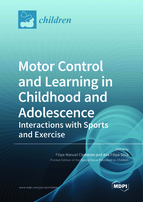Motor Control and Learning in Childhood and Adolescence: Interactions with Sports and Exercise
A special issue of Children (ISSN 2227-9067).
Deadline for manuscript submissions: closed (31 December 2021) | Viewed by 23973
Special Issue Editors
Interests: football; soccer; match analysis; performance analysis; network analysis
Special Issues, Collections and Topics in MDPI journals
Interests: motor development; motor control and learning; exercise and brain function; sports training
Special Issues, Collections and Topics in MDPI journals
Special Issue Information
Dear Colleagues,
The production and control of human movement is a progressive and complex process that is developed across the lifespan. New motor patterns can be learned using movement and considering the interactions with the environment. Through affordances, the human is challenged and interacts with the environment to solve problems and to improve decisions. Therefore, motor control and motor learning are two core topics that should be considered in children and young populations. Motor control is dedicated to analyzing the mastering of voluntary movement, while motor learning is more related to the process of acquiring a skill or producing a new motor task. Many types of research are produced annually on these topics. However, within the pandemic context, changes in the stimuli provided to children are the reason for concern for their development. Less free play or structured practice (e.g., sports, physical education) may have consequences for the learning and mastering of human movement. Not exclusively focusing on this situation, but opening a window to its discussion, this Special Issue “Motor Control and Learning in Childhood and Adolescence: Interactions with Sports and Exercise” aims to be a space for publishing innovative articles or systematic reviews dedicated to motor control and learning in the field of sports and exercise.
Considering that more research should be done and published about such important topics, the aim of the Special Issue “Motor Control and Learning in Childhood and Adolescence: Interactions with Sports and Exercise” is to publish high-quality original investigations as well as narrative and systematic reviews in the field of motor control and learning in sports and exercise. We look forward to receiving contributions related (but not limited) to the following topics: (I) experimental studies and interventions for teaching and improving skill acquisition in children; (II) observational analytic studies identifying the effects of specific conditions or covariables occurring in sports and exercise on motor control and learning; (III) systematic reviews and meta-analyses that may summarize the evidence about the effects of sport and exercise on motor control and learning.
Dr. Filipe Manuel Clemente
Dr. Ana Filipa Silva
Guest Editors
Manuscript Submission Information
Manuscripts should be submitted online at www.mdpi.com by registering and logging in to this website. Once you are registered, click here to go to the submission form. Manuscripts can be submitted until the deadline. All submissions that pass pre-check are peer-reviewed. Accepted papers will be published continuously in the journal (as soon as accepted) and will be listed together on the special issue website. Research articles, review articles as well as short communications are invited. For planned papers, a title and short abstract (about 100 words) can be sent to the Editorial Office for announcement on this website.
Submitted manuscripts should not have been published previously, nor be under consideration for publication elsewhere (except conference proceedings papers). All manuscripts are thoroughly refereed through a single-blind peer-review process. A guide for authors and other relevant information for submission of manuscripts is available on the Instructions for Authors page. Children is an international peer-reviewed open access monthly journal published by MDPI.
Please visit the Instructions for Authors page before submitting a manuscript. The Article Processing Charge (APC) for publication in this open access journal is 2400 CHF (Swiss Francs). Submitted papers should be well formatted and use good English. Authors may use MDPI's English editing service prior to publication or during author revisions.
Keywords
- motor control
- motor learning
- motor development
- youth sports
- exercise








